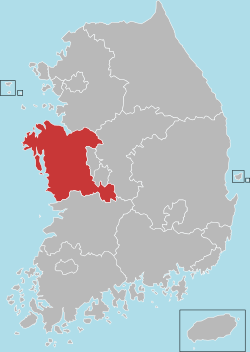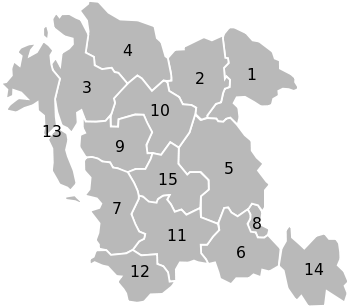South Chungcheong Province
South Chungcheong Province (Korean: 충청남도, Chungcheongnam-do), also known as Chungnam, is a province of South Korea. South Chungcheong has a population of 2,059,871 (2014) and has a geographic area of 8,204 km2 (3,168 sq mi) located in the Hoseo region in the southwest of the Korean Peninsula. South Chungcheong borders the provinces of Gyeonggi to the north, North Chungcheong, Sejong Special Autonomous City, and Daejeon Metropolitan City to the east, and North Jeolla to the south.
South Chungcheong Province 충청남도 | |
|---|---|
| Chungcheongnam-do Korean pronunciation: [tɕʰuŋ.tɕʰʌŋ.nam.do] | |
| Korean transcription(s) | |
| • Hangul | 충청남도 |
| • Hanja | 忠淸南道 |
| • McCune‑Reischauer | Ch'ungch'ŏngnamdo |
| • Revised Romanization | Chungcheongnam‑do |
 Flag  | |
 | |
| Country | South Korea |
| Region | Hoseo |
| Capital | Hongseong County |
| Subdivisions | 8 cities; 7 counties |
| Government | |
| • Governor | Yang Seung-jo (Democratic) |
| Area | |
| • Total | 8,204 km2 (3,168 sq mi) |
| Area rank | 6th |
| Population (October 2014) | |
| • Total | 2,059,871[1] |
| • Rank | 4th |
| • Density | 235/km2 (610/sq mi) |
| Metropolitan Symbols | |
| • Flower | Chrysanthemum |
| • Tree | Weeping willows |
| • Bird | Mandarin duck |
| Dialect | Chungcheong |
| Website | chungnam.net |
Hongseong County is the capital and Cheonan is the largest city of South Chungcheong, with other major cities including Asan, Seosan, and Dangjin. Daejeon was the largest city of South Chungcheong until becoming a Metropolitan City in 1989, and the historic capital until the provincial government was relocated to Hongseong in 2012.
South Chungcheong was established in 1896 from the province of Chungcheong, one of the Eight Provinces of Korea, consisting of the southwestern half of the territory. South Chungcheong was known as Chūsei-nan Prefecture during the Japanese Colonial Period from 1910 and became part of South Korea following the division of Korea in 1945.
Overview
Chungcheongnam-do is South Korea's richest province, with a 2012 GDP per capita of $56,133. It is by far South Korea's fastest growing region, with an average GDP growth of 9.7% in 2001-2007[2] that accelerated to 12.4% in 2010.[3] Such rapid growth transformed it from a mostly agricultural to a highly industrialized economy in the 21st century.
Along with Gangwon, Chungnam is the only province outside the Seoul Capital Area to be served by the Seoul Metropolitan Subway, with Seoul Subway Line 1 passing Cheonan and Asan. Multimillion-dollar projects are being developed, such as New Asan City centered on the newly built Cheonan-Asan Station that connects Chungnam's largest city, Cheonan, to Seoul Station in less than 30 minutes via the KTX bullet train.
Geography
The province is part of the Hoseo region, and is bounded to the west by the Yellow Sea, to the north by Gyeonggi-do province, to the south by Jeollabuk-do province, and to the east by Chungcheongbuk-do province. Its area is 8,204 km2 (3,168 sq mi) as of 2012.[4]
Resources
One third of the province's area is under cultivation. Aside from agriculture, marine products are of importance. There are 220 square kilometres (85 sq mi) of exposed beach which is used to produce salt by solar evaporation. There is coal mining, but gold and silver mines are also found in Chungcheongnam-do, as is Monazite (a rare thorium bearing mineral) and zircon.
In 2018, South Chungcheong province was home to half of South Korea's coal-fired power generation capacity. That year, it became the first Asian member of the Powering Past Coal Alliance, and committed to ending the use of coal power to mitigate global warming and reduce air pollution.[5]
Attractions
At 845 metres, Mount Gyeryong is the most notable elevation. It is located in a national park which is noted for its unique rock features. Apart from the stone formations there are a number of old temples. These include Gwanchok-sa, a temple which is home to the largest stone Buddha in Korea.[6] In 1978 the Taean Marine National Park was opened. It includes some of the country's best bathing beaches, and Cheollipo Arboretum which was created in 1966 by C. Ferris Miller and contains approximately 14,000 different plant species, including some rare and endangered species.
Sejong City
In early 2007, the Republic of Korea government decided to create a special administrative district out of part of the present Chungcheongnam-do Province, near what is now Daejeon. The new district was named Sejong Special Self-Governing City, and was to replace Seoul as the future capital of the Republic of Korea. However, in 2009, it was determined that replacing Seoul as new national capital would violate the South Korean Constitution by Constitution Court. Now Sejong City may only serve as a National Administrative Capital and Secondary capital alongside Seoul, representing about 36 government ministers and agencies, including the Prime Minister's office, as of 2015.
Administrative divisions
Chungcheongnam-do is divided into 8 cities (si) and 7 counties (gun). The city and county names below are given in English, Hangul, and Hanja.
| Map | # | Name | Hangul | Hanja | Population (2013)[7] | Subdivisions |
|---|---|---|---|---|---|---|
 | ||||||
| — Specific City — | ||||||
| 1 | Cheonan | 천안시 | 天安市 | 584,240 | 2 ilban-gu — 4 eup, 8 myeon, 18 haengjeong-dong | |
| — City — | ||||||
| 2 | Asan | 아산시 | 牙山市 | 283,121 | 2 eup, 9 myeon, 6 haengjeong-dong | |
| 3 | Seosan | 서산시 | 瑞山市 | 163,800 | 1 eup, 9 myeon, 5 haengjeong-dong | |
| 4 | Dangjin | 당진시 | 唐津市 | 156,026 | 2 eup, 9 myeon, 3 haengjeong-dong | |
| 5 | Gongju | 공주시 | 公州市 | 116,838 | 1 eup, 9 myeon, 6 haengjeong-dong | |
| 6 | Nonsan | 논산시 | 論山市 | 126,086 | 2 eup, 11 myeon, 2 haengjeong-dong | |
| 7 | Boryeong | 보령시 | 保寧市 | 105,355 | 1 eup, 10 myeon, 5 haengjeong-dong | |
| 8 | Gyeryong | 계룡시 | 雞龍市 | 40,997 | 3 myeon, 1 haengjeong-dong | |
| — County — | ||||||
| 9 | Hongseong County | 홍성군 | 洪城郡 | 89,174 | 2 eup, 9 myeon | |
| 10 | Yesan County | 예산군 | 禮山郡 | 85,626 | 2 eup, 10 myeon | |
| 11 | Buyeo County | 부여군 | 扶餘郡 | 72,959 | 1 eup, 15 myeon | |
| 12 | Seocheon County | 서천군 | 舒川郡 | 58,740 | 2 eup, 11 myeon | |
| 13 | Taean County | 태안군 | 泰安郡 | 62,519 | 2 eup, 6 myeon | |
| 14 | Geumsan County | 금산군 | 錦山郡 | 55,433 | 1 eup, 9 myeon | |
| 15 | Cheongyang County | 청양군 | 靑陽郡 | 32,105 | 1 eup, 9 myeon | |
Religion
Religion in Chungcheongnam-do (2005)[8]
According to the census of 2005, of the people of Chungcheongnam-do 20.5% follow Buddhism and 28.7% follow Christianity (19.6% Protestantism and 9.1% Catholicism).[8] 50.8% of the population is mostly not religious or follow Muism and other indigenous religions.
Education
- Kongju National University
- Gongju National University of Education
- Korea National University of Cultural Heritage
- Dankook university in Cheonan
- Baekseok University
- Soonchunhyang University in Asan
- GEONYANG University in Nonsan
- Korea University of Technology and Education in Cheonan
Twin towns – sister cities
Chungcheongnam-do is twinned with:

.svg.png)
See also
- List of Korea-related topics
References
- "Archived copy". Archived from the original on 2014-11-29. Retrieved 2015-10-01.CS1 maint: archived copy as title (link)
- http://www.mt.co.kr/view/mtview.php?type=1&no=2009072818220114676&outlink=1
- http://www.index.go.kr/egams/stts/jsp/potal/stts/PO_STTS_IdxMain.jsp?idx_cd=1008&bbs=INDX_001
- 일반현황 (in Korean). Chungcheongnam-do. Retrieved 18 March 2013.
- "South Chungcheong Province, home to half of South Korea's coal power generation, joins PPCA | Powering Past Coal Alliance". Powering Past Coal Alliance (PPCA). Retrieved 2019-10-06.
- "Gwanchoksa Temple (관촉사) - Official Korea Tourism Organization". english.visitkorea.or.kr.
- "Population-Households". Chungcheongnam-do. March 2013. Retrieved 7 June 2013.
- "2005 Census - Religion Results". Archived from the original on 2015-09-04.
- "Sister/Twin Cities of Balıkesir" (PDF).
External links
| Wikimedia Commons has media related to Chungcheongnam-do. |